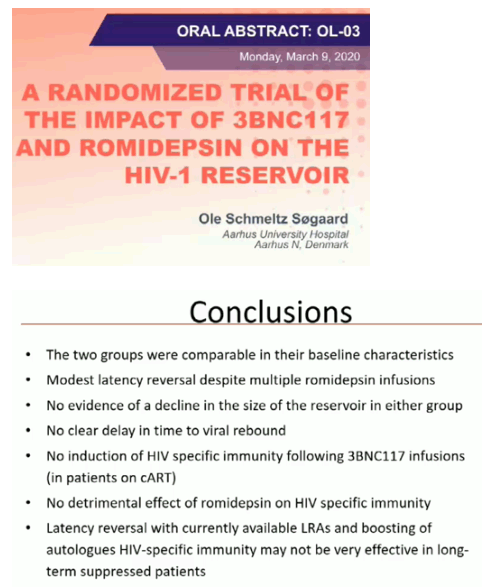| |
A RANDOMIZED TRIAL OF THE IMPACT OF 3BNC117 AND ROMIDEPSIN ON THE HIV-1 RESERVOIR
|
| |
| |
CROI 2020
http://www.croiwebcasts.org/console/player/44589?mediaType=slideVideo&

Henning Gruell1, Yehuda Z. Cohen2, Jesper D. Gunst3, Marie H. Pahus3, Clara Lehmann1, Katrina Millard2, Martin Tolstrup3, Julio C. Lorenzi2, Michel Nussenzweig2
1Cologne University Hospital, Cologne, Germany,2The Rockefeller University, New York, NY, USA,3Aarhus University Hospital, Aarhus, Denmark
Abstract
Broadly neutralizing antibodies (bNAbs) administered prior to reversal of latency may facilitate killing of HIV-1-infected CD4+ T cells and could be a component of an HIV-1 cure strategy. To clinically assess this concept in individuals on antiretroviral therapy (ART), we evaluated the impact of the bNAb 3BNC117 followed by latency reversal with romidepsin on measures of viral transcription, reservoir size, as well as time to viral rebound during analytical treatment interruption (ATI).
This randomized phase Ib/IIa trial enrolled 20 HIV-1-infected adults on long-term ART. Group A received 3BNC117 (30 mg/kg) 2 days prior to each romidepsin cycle, with romidepsin (5 mg/m2) administered at weeks 0, 1, and 2 (cycle 1), and weeks 8, 9, and 10 (cycle 2). Group B received cycles 1 and 2 but no 3BNC117. This was followed by an ATI at week 24 when bNAb levels were expected to be low or undetectable. The primary endpoint was time to viral rebound (≥200 copies/mL) during ATI. Secondary endpoints were safety, changes in HIV-1 reservoir measures, as well as effects on HIV-1-specific immunity.
Nineteen of 20 enrolled participants (3 females, 17 males, median age 44 years, median of 645 CD4+ cells/mm3) completed all treatment cycles; 11 in Group A and 8 in Group B. Two participants (one in each group) opted out of the ATI. Seven participants (Group A = 4, Group B = 3) had detectable viral blips (21-144 copies/ml) after romidepsin infusions. Unspliced HIV-1 RNA increased in most individuals after the 2nd and 3rd infusions in each romidepsin cycle. Decline in total HIV-1 DNA was 90 vs 61 copies/106 CD4+ T cells for group A vs B (p=0.79). Median time from interrupting ART to plasma HIV-1 RNA 200 copies/ml during ATI was 2.5 weeks for Group A and 4.0 weeks for Group B. A total of 237 AEs were recorded (184 grade 1, 52 grade 2, and 1 grade 3), of which 64 (27.4%) were considered at least possibly related to study medications.
This is the first reported trial of the combination of a latency-reversing agent and potent bNAb designed to target the HIV-1 reservoir. While the combination was safe, it did not reduce the combined defective and intact proviral reservoir as measured by total HIV DNA, or delay viral rebound during ATI. These results may serve as a benchmark for further optimization of HIV-1 cure strategies under ART.
|
|
| |
| |
|
|
|